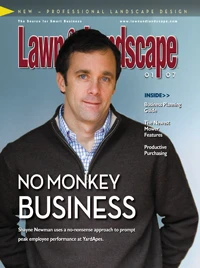All growth is good.
However, is one method of increasing the size of a landscape business a more solid, advantageous or strategic decision than others? It’s an interesting dilemma for landscape contractors as they grow their businesses and strengthen their strategic positions in their respective marketplaces. Lawn & Landscape Message Board participant Chad Stern posed a similar question recently about growth to his online colleagues.
Stern, owner of Mowing & More based in Chevy Chase, Md., says he wants to grow his company 100 percent organically, or increase its size and scope solely through his own profits and without outside investment.
|
|
“A service company that is very labor and employee intensive requires a very solid framework and infrastructure as it grows,” Stern posts. “I personally think that organic growth is the best way to ensure that my company does not grow at a rate faster than my ability to manage that growth.”
Stern acknowledged organic growth will grow his company at a much slower rate than it would through an infusion of outside cash, and that he doubts his company will reach the $100 million milestone during his lifetime. However, Stern was still curious as to whether the infusion of capital from an outside investor created a growth rate that was unmanageable, both for the owner and for the company’s existing infrastructure.
Message board participant Steve Cissel, founder and chief executive officer of the online green industry directory GIYP.com, posts that he believes an organic approach is too slow and that the rest of the marketplace evolves at a much faster rate.
“Trying to grow a business without utilizing borrowing power will not grow the business fast enough to profit from the opportunities in the marketplace,” Cissel says.
Investor-oriented growth, however, provides the financial means to grow a landscape business at a much more rapid, and steady, rate, he says, adding there are a couple of routes a contractor could pursue for funding.
For example, a venture capitalist (VC) is an investor who wants equity – ownership – in the business, Cissel posts. However, the VC may want to be a part of the decision making process at the landscape firm. Likewise, a major drawback with obtaining VC money is that the investor expects large returns from the business and wants to see aggressive growth rates – upwards to 100 percent, Cissel says.
Another type of investor, Cissel posts to the online message board, is an individual who wants to loan cash in order to receive a financial return but without owning any part of the business. This type of investor could be a bank, family member, wealthy individual, etc. Cissel adds he’s used this type of investor since 1987 to grow his company.
“Early on it was a loan from my grandparents that was structured as interest-only for the first 5 years, then principle and interest for the next 5 years until the note was paid off,” Cissel says. “Then I had a track record to show the loan officer at the bank and I established a line of credit. I used it to its full extent early in the year and paid it off by year’s end.
“Recently, I doubled (my company's credit line) to expand my operation,” he explains. “The plan was to pay it down half (of the loan) the first year, then use (the loan) to its max the second year and then pay it all off in full the third year. Then it should be available again.”
Many seasoned contractors offered that many banks, especially those with small business lending programs, will offer contractors modest – typically less than $25,000 – lines of credit. For larger sums of money, a bank will demand a more aggressive background check of the borrower’s financial history.
WHAT TO BORROW FOR. During a previous online post involving investing and growth, landscape contractor Keith Wiggins queried the online message board participants as to whether obtaining investment money to support a marketing initiative was a sound business decision for a landscape contractor.
“I know that with my marketing plan I can drive my company to its next level and double or triple the investment in a year or two,” Wiggins posts. “My question is should I consider finding an investor? I want my company to grow and I keep hearing, ‘You’ve got to spend money to make money.’”
Kelly Tohill, owner of Atlanta-based Tohill Landscape Management, posts there are cheaper alternatives to growth. And reaching the “next level” requires more selling than anything else, he says
“Go pound on some doors and network,” Tohill posts. “Going and talking to people doesn’t cost a lot of money.”
Cissel doesn’t necessarily agree with securing outside funding for intangibles, such as marketing and sales. Instead, Cissel suggests only financing big-ticket items, such as trucks and real estate.
“If I was to wait until I had enough cash to pay for trucks or a shop I would grow too slowly,” Cissel says. “Sometimes you can borrow money for trucks for almost nothing, so it does not make sense to pay in cash.”
Secondly, Cissel believes a young landscape company should be committing 7 to 10 percent of its income to marketing, whereas a mature company should be investing 4 to 7 percent.
“Leveraging cash to throw at marketing would scare the (heck) out of me,” Cissel says. “So much of marketing is brand building/name building and does not turn into revenue.”
Wiggins, however, posts, that in his particular case, this sage advice is easier said than done. As a lawn maintenance and landscaping contractor, Wiggins posts his profits are not large enough to grow organically. Likewise, he has the equipment to take on additional work, but not the clients.
“That’s my problem, I need a heck of a lot more mowing customers,” Wiggins say, adding he’d want to be at 400 accounts within the next two years. “Should I ask a rich friend if they would lend/invest money so I can target my marketing strategy better and get the work and grow the way I want to?”
Cissel recommends examining the firm's marketing plan and choosing items – such as building word-of-mouth referrals from existing clients – that can fit within the company’s current budget allowance.
“You’ve got to be creative and figure out a way to get it done,” Cissel posts.
Some participants weighed in that, ultimately, a landscape contractor needs to carefully consider what they’re willing to sacrifice – such as control over of a portion of their company – for the financial ability to grow at a more aggressive rate.

Explore the January 2007 Issue
Check out more from this issue and find your next story to read.
Latest from Lawn & Landscape
- Wilson360 adds Daniel Grange as new consultant
- Batman and business
- CH Products releases new tree stabilizer
- Savannah Bananas founder Jesse Cole to speak at Equip Exposition
- Catch up on last year's Benchmarking report
- Davey Tree promotes Kevin Marks as VP of Western operations
- Bobcat Company names 2025 Dealer Leadership Groups
- Green Lawn Fertilizing/Green Pest Solutions awards employee new truck for safe driving






